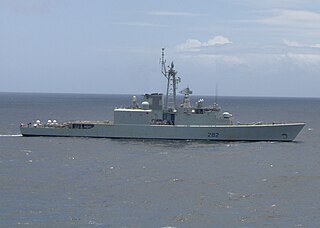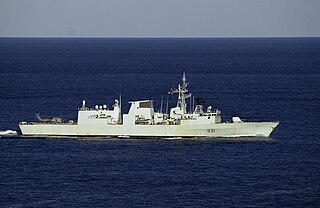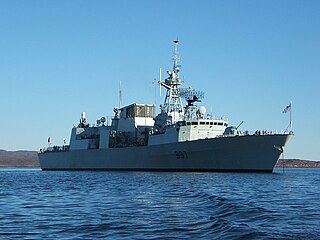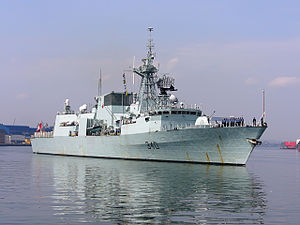
The Royal Canadian Navy is the naval force of Canada. The navy is one of three environmental commands within the Canadian Armed Forces. As of February 2024, the RCN operates 12 Halifax-class frigates, 12 Kingston-class coastal defence vessels, 4 Victoria-class submarines, 2 Harry DeWolf-class offshore patrol vessels, 8 Orca-class patrol vessels, and several auxiliary vessels. The RCN consists of 8,400 Regular Force and 4,100 Primary Reserve sailors, supported by 3,800 civilians. Vice-Admiral Angus Topshee is the commander of the Royal Canadian Navy and chief of the Naval Staff.

Iroquois-class destroyers, also known as Tribal class or DDG 280 class, were a class of four helicopter-carrying, guided missile destroyers of the Royal Canadian Navy. The ships were named to honour the First Nations of Canada.

HMCS Toronto is a Halifax-class frigate that has served in the Canadian Forces since 1993. Toronto is the fourth ship in her class which is the name for the Canadian Patrol Frigate Project. She is the second RCN ship to be named for Canada's largest city. When not on operations she is assigned to Maritime Forces Atlantic (MARLANT) and is based at CFB Halifax. Toronto serves on MARLANT missions protecting Canada's sovereignty in the Atlantic Ocean and enforcing Canadian laws in its territorial sea and exclusive economic zone.

HMCS Athabaskan was an Iroquois-class destroyer that served in the Royal Canadian Navy from 1972 until 2017. Athabaskan was the third ship of her class which is sometimes referred to as the Tribal class or simply as the 280 class. She is the third vessel to use the designation HMCS Athabaskan.

The Halifax-class frigate, also referred to as the City class, is a class of multi-role patrol frigates that have served the Royal Canadian Navy since 1992. The class is the outcome of the Canadian Patrol Frigate Project, which dates to the mid-1970s. HMCS Halifax was the first of an eventual twelve Canadian-designed and Canadian-built vessels which combine traditional anti-submarine capabilities with systems to deal with surface and air threats as well. Ships of the class are named after capital cities of Canadian provinces, the capital of Canada, Ottawa, and the major cities of Calgary, Montreal, and Vancouver.

HMCS Halifax is a Halifax-class frigate that has served in the Royal Canadian Navy and Canadian Forces since 1992. Halifax is the lead ship in her class which is the name for the Canadian Patrol Frigate Project. She is the second vessel to carry the designation HMCS Halifax. She carries the hull classification symbol FFH 330.

HMCS Vancouver is a Halifax-class frigate, of the Royal Canadian Navy launched on 8 July 1989, as the second vessel of her class. She is based at CFB Esquimalt on the west coast of Canada, and is the third vessel to be named after Vancouver, British Columbia.

HMCS Goose Bay is a Kingston-class coastal defence vessel that has served in the Canadian Forces since 1998. Goose Bay is the eighth ship of her class which is the name for the Maritime Coastal Defence Vessel Project. She is the first vessel to be named Goose Bay. The coastal defence vessel is assigned to Maritime Forces Atlantic (MARLANT) and is homeported at CFB Halifax.

HMCS Calgary is a Halifax-class frigate that has served in the Canadian Forces and Royal Canadian Navy since 1995. Calgary is the sixth vessel in her class and the second vessel to carry the designation HMCS Calgary. She was built as part of the Canadian Patrol Frigate Project. Calgary began the FELEX refit in June 2012. She is assigned to Maritime Forces Pacific (MARPAC) and is homeported at CFB Esquimalt. Calgary serves on MARPAC missions protecting Canada's sovereignty in the Pacific Ocean and enforcing Canadian laws in its territorial sea and exclusive economic zone.

HMCS Montréal is a Halifax-class frigate that has served in the Canadian Forces since 1993. Montréal is the seventh ship in her class which is based on the Canadian Patrol Frigate Project. She is the second vessel to carry the designation HMCS Montreal. She is assigned to Maritime Forces Atlantic (MARLANT) and is homeported at CFB Halifax. Montréal serves on MARLANT missions protecting Canada's sovereignty in the Atlantic and Arctic Oceans and enforcing Canadian laws in its territorial sea and Exclusive Economic Zone. The ship has also been deployed on missions throughout the Atlantic and to the Indian Ocean; specifically the Persian Gulf and Arabian Sea on anti-terrorism operations. The vessel has also participated in several NATO missions, patrolling the Atlantic Ocean as part of Standing Naval Force Atlantic (STANAVFORLANT) and its successor Standing NATO Response Force Maritime Group 1 (SNMG1). The vessel is designated as a Bilingual Language Unit in the Royal Canadian Navy.

HMCS Fredericton is a Halifax-class frigate that has served in the Canadian Forces since 1994. Fredericton is the eighth ship in her class which is based on the Canadian Patrol Frigate Project. She is the second vessel to carry the name. Fredericton serves on MARLANT missions protecting Canada's sovereignty in the Atlantic Ocean and enforcing Canadian laws in its territorial sea and Exclusive Economic Zone. Fredericton has also been deployed on missions throughout the Atlantic and to the Indian Ocean; specifically the Persian Gulf and Arabian Sea on anti-terrorism operations. Fredericton has also participated in several NATO missions, patrolling the Atlantic Ocean as part of Standing Naval Force Atlantic (STANAVFORLANT) and its successor Standing NATO Response Force Maritime Group 1 (SNMG1). The frigate is assigned to Maritime Forces Atlantic (MARLANT) and is homeported at CFB Halifax.

HMCS Charlottetown is a Halifax-class frigate that has served in the Royal Canadian Navy since 1995. Charlottetown is the tenth ship in her class which is based on the Canadian Patrol Frigate Project. She is the third vessel to carry the designation HMCS Charlottetown. Charlottetown, assigned to Maritime Forces Atlantic (MARLANT) and homeported at CFB Halifax, serves on missions protecting Canada's sovereignty in the Atlantic Ocean and enforcing Canadian laws in its territorial sea and exclusive economic zone. Charlottetown has also participated in several NATO missions, patrolling the Atlantic Ocean as part of Standing Naval Force Atlantic (STANAVFORLANT) and its successors Standing NATO Maritime Group 1 and 2. Charlottetown has also been deployed on missions throughout the Atlantic and to the Indian Ocean, specifically the Persian Gulf and Arabian Sea on anti-terrorism operations.

HMCS Ottawa is a Royal Canadian Navy Halifax-class frigate. Ottawa is the twelfth and final ship of the Halifax class that were built as part of the Canadian Patrol Frigate Project. She is the fourth vessel to carry the name HMCS Ottawa. The first three were named for the Ottawa River. This ship is the first named for Canada's national capital, the City of Ottawa. She is assigned to Maritime Forces Pacific (MARPAC) and is homeported at HMC Dockyard, CFB Esquimalt. Ottawa serves on MARPAC missions protecting Canada's sovereignty in the Pacific Ocean and enforcing Canadian laws in its territorial sea and Exclusive Economic Zone. Ottawa has also been deployed on missions throughout the Pacific and to the Indian Ocean; specifically the Persian Gulf and Arabian Sea on anti-terrorism operations.

HMCS Regina is a Halifax-class frigate that has served in the Canadian Forces and Royal Canadian Navy since 1993. Regina is the fifth vessel in her class which is the name for the Canadian Patrol Frigate Project. She is the second vessel to carry the designation HMCS Regina. She is assigned to Maritime Forces Pacific (MARPAC) and is homeported at CFB Esquimalt.

HMCS Ville de Québec is a Halifax-class frigate that has served in the Canadian Forces and Royal Canadian Navy since 1993. Ville de Québec is the third vessel in her class which is the name for the Canadian Patrol Frigate Project. The frigate is the second Royal Canadian Navy ship to be named Ville de Québec and is Canada's only fully bilingual warship. She is assigned to Maritime Forces Atlantic (MARLANT) and is homeported at CFB Halifax. The vessel serves on MARLANT missions protecting Canada's sovereignty in the Atlantic Ocean and enforcing Canadian laws in its territorial sea and exclusive economic zone.

HMCS Winnipeg is a Halifax-class frigate that has served in the Royal Canadian Navy since 1996. Winnipeg is the ninth ship in her class, whose design emerged from the Canadian Patrol Frigate Project. She is the second Canadian warship to carry the name HMCS Winnipeg. Winnipeg serves on Canadian Forces MARPAC missions protecting Canada's sovereignty in the Pacific Ocean and the Arctic Ocean and in enforcing Canadian laws on its territorial oceans and Exclusive Economic Zone. The vessel has been deployed on missions throughout the Pacific, and also to the Indian Ocean; specifically on anti-terrorism operations in the Persian Gulf and the Arabian Sea, and counter-piracy operations off the coast of Somalia. The ship is assigned to the Maritime Forces Pacific (MARPAC), and she has her home port at the Canadian Forces Maritime Base at Esquimalt.

HMCS Kingston is a Kingston-class coastal defence vessel that has served in the Canadian Forces since 1996. Kingston is the lead ship of her class, ordered under the Maritime Coastal Defence Vessel Project. She is the first vessel to use the designation HMCS Kingston. She is assigned to Maritime Forces Atlantic (MARLANT) and is homeported at CFB Halifax.

HMCS Shawinigan is a Kingston-class coastal defence vessel that has served in the Canadian Forces and the Royal Canadian Navy since 1997. Shawinigan is the fifth ship of her class. She is the second vessel to use the designation HMCS Shawinigan. The ship is assigned to Maritime Forces Atlantic (MARLANT) and is homeported at CFB Halifax.

MV Asterix is a Canadian commercial container ship. It was purchased by Federal Fleet Services as part of Project Resolve, and was later converted into a supply ship for the Royal Canadian Navy (RCN). She is intended to act as an interim replacement between the out of service Protecteur-class replenishment oiler and the future Protecteur-class auxiliary vessel. Originally launched in Germany in 2010 as Cynthia, the ship was converted and delivered to the RCN in December 2017 when she will be leased to the navy with a merchant navy crew, complemented by RCN personnel. Asterix will be in Canadian service well into the 2020s.




















